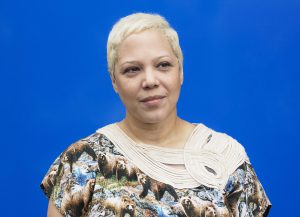
In The Cape Project, photographer Saundra Karol asks women and girls to search inside themselves and find the superheroes within. The subject of each portrait writes down the story of her greatest strengths, wears a cape, and poses for a photograph. The result is an empowering series that celebrates the strength within every female.
Forming an arresting play of light, black and white photographs, unframed and floating, are fastened by clips to wire rather than set flush against the studio wall. Below the photos hang the subjects’ accompanying stories, typed onto sheets of paper that can be moved, shifted, and exchanged, a presentation as fluid as the fabric that has come to physicalize the subjects’ inner power. The stories are interchangeable and thus universal. Their strengths, expressed through word and image, are our own.
The Cape Project marks Saundra’s first exhibition, and I chatted with her during the 2nd Friday opening reception at Pilsen’s Fountainhead Lofts on April 8.
The next 2nd Friday event in the Chicago Arts District is May 13 from 6-10pm.

Jenny Lam: Is this the first time you’ve exhibited this project?
Saundra Karol: This is. This is actually my very first exhibition overall, so I thought I’d start out nice and powerful, and nice and strong.
JL: This is a wonderful way to start. I didn’t expect the subjects’ statements to be displayed directly underneath the photographs like that.
SK: Thank you. I toyed with different ideas of course, and, first of all, I was thinking in a traditional sense of just matting and framing every single image, and as I got more and more involved, it started to seem a little bit complicated [laughter], and it also didn’t seem to fit; a traditional matting and framing does not fit the style of the project and what I wanted to convey, and so I had quite a few restless nights and decided on the wires, and I’m very happy with how it turned out. It’s really what I had in my head, with the stories simply put there on paper. I let the stories and images speak for themselves.
JL: I understand you primarily do portrait photography. How did you make the transition from maternity and child photos to this project?
SK: I wouldn’t really call it a huge transition; I would say it’s another part of me. Of course, my bread and butter is doing the maternity, the newborn photography—I also do some headshots—but this is just something that’s more on a personal level, so I’m putting my personal self out there with this. Yeah, there’s a part of me in all of my portraits including maternity and newborn, but this really is my heart.

JL: How did you come up with the idea?
SK: Actually, it’s been a very evolved process; it started over a year ago. I wanted to do something that really made an impact on society. I mean, I really care about my clients, I do, [but] I wanted something that really spoke to my spirit. [laughter] Not to be cheesy or anything, but really something that excited me and something that challenged me as well.
So I thought about different things, and gender issues has always been something I’ve been very interested in. I was never a Gender Studies person or anything—I studied Communication and Theatre—but that’s what really spoke to me.
And so I was going to stick to children—boys and girls—and I was planning on just taking the kids and working with different kinds of innate expectations as well as expectations placed on kids by society. I started with photographing a boy holding a doll, playing with his doll, and then I also worked with this one girl—you know how they sell those little plastic shoes, the high heels?—I put her in those; she had her mom’s big purse her mom says she likes to play with. So I took images of her with that, and I actually have that one on my website right now because I just like the image, but then I started running into brick walls.
I met with a professor, one of my former professors, and she suggested, “Do more of a field study thing,” and observing families, observing kids, and capturing them in moments that kind of defied normal societal expectations. But I figured I didn’t have twenty years to devote to it after thinking about that, and kept thinking about it and thinking about it, and it really evolved into this, what it is today, which is not only about kids, but also about adults, so it’s been kind of a long process, but I like where it went. I won’t complain about the process; it turned out the way it should have, I think.

JL: Did you learn anything about yourself as you were taking this year-long journey?
SK: I didn’t start shooting until close to March, really, so doing this part of the project was done very recently. Honestly, [with] the first person I shot, I started learning about myself; by the second person, I knew that this was going to impact me very strongly. And it was very powerful, because I went into it a little bit, “We’ll just see where it’s going, where it’s going to go to,” but once I started shooting, by the second person, I was hooked, and I started seeing the way I look at strengths in people changing.
You can say you are not gender-biased, [and] you can say that you don’t try to judge too harshly, but we do, and being involved in this, it’s opened me up and made me much more accepting of people’s roles and seeing the strength in those roles and people’s decisions to be in those roles as well, so it’s not like they had to do that; they find strength in what they’re doing and they should be proud of it, and it’s opened my mind to that.

JL: That’s awesome. How do you find your subjects? Do people who want to participate contact you, or do you approach people you would like to photograph?
SK: To find the first people, I went on Facebook; I got my family and friends to do it, and that was kind of difficult, saying, “OK, I want you to tell me about yourself—your strengths, tell me your deep strengths—and you’re going to put on a cape, and I’m going to shoot you!” That doesn’t sound so great, but once I got the first few people who trusted me… and it was all about trust: “OK, Saundra, we know you’re not going to screw this up; you’re not going to make me look bad.” I tried to feign my confidence in the beginning to get them in, and it worked, and once the first few people were involved, I think it was easier for other people to step up to the plate, so the first ten people—even this whole wall of people—I owe a lot of thanks to, because they’re making it easier for other people to come forward and be involved in this.
And this project makes people talk. I’ve had so many people say, “We were on our way here, or over dinner last night, we were talking about our strengths, and it’s due to you doing this project,” and that makes me feel really good that it’s getting people talking, but once you get people talking, then they’re talking to their friends and their family, and they want to be involved, so it’s been like a snowball effect with getting people in here.

JL: I understand you want to focus on reaching out to and bringing this project to children, especially young girls. Would you want this show to travel then?
SK: I do. Yeah, I would love to take it… I have one college campus [Indiana University Northwest] interested. I want to take it to schools, Girl Scout troops, everybody. I think that reaching all ages is very important because, even as people get older, we need to be reminded of our strengths. We need people to say, “Hey, it’s OK to be strong; it’s OK to put that out there; it’s OK to be who you are,” and we need that at every stage of our lives, I think, because we change.
JL: What are your own strengths?
SK: I have so many; which ones do I…! [laughter] That’s the thing; everybody has so many, and for this project you have to decide which strengths you want to focus on. For me, I focused on my childhood and my photography business. From what I had on my website, I changed it a little bit. I don’t like to settle, I’m always a big dreamer, I like to go for things, and I’m not scared to go for things like the project.
One thing I did not talk about is the strength even in deciding to do this and going ahead and not being scared to take something like this on, because when I started, it seemed like it wouldn’t be that difficult, but the difficult part… doing the images is not hard—setting up the lighting, saying, “OK, here’s a piece of paper; write your story”—the hard part is not taking in the stories. It’s not letting them bring you down; some of them are deep. And, even as I was setting this up, I made sure that I felt every story—while I put the clips on, walked over, read the story, put it up—so each story became a part of me. I left here feeling inspired, but sometimes you have to try not to be down, because you’re internalizing other people’s stories, other people’s strengths, some people’s weaknesses, and it can kind of be overpowering, so I think being just open to continuing that and keeping my walls centered is a big strength.

JL: Are these portraits arranged in a specific way?
SK: No, not really. There are a few things I looked at aesthetically, but, overall, they’re not. I mean, I didn’t want too many long stories by the bar. [laughter] I wanted to have one long story over there, so if somebody’s waiting a while, they can have something to read. But overall I tried to space them out so there weren’t too many kids next to each other, stuff like that.
And I just love looking at… like the one on the end, the pregnant woman, she was actually the last maternity shoot that I had. So that was the only client [to whom] I said, “Hey! You’re here! And it would be really great to involve somebody who is about to have a baby. Would you be willing to do this?” And she was very quiet, and even in her story, she says, “People think I’m timid,” and she sat down, and she was writing and writing and writing, and as you see her story isn’t one of the shortest, and I thought it was really fantastic that once you give somebody an outlet, they’re like, “OK, I will get into this,” and it’s really cool.
JL: One of this project’s own strengths is that can be continuous. Will you be exhibiting more in the future?
SK: I plan to. I actually want to involve the community, so I want to bring people back. I would love to shoot the community, have certain times where people come back and throw on a cape, and have people write out their story right here during 2nd Fridays, so I plan to do that either next month or after, and get people talking about it and involved, because it’s a project for everybody.
For more information about Saundra Karol and The Cape Project, visit www.thecapeproject.com and www.saundrakarol.com.
To participate in The Cape Project, e-mail info@thecapeproject.com.
Jenny Lam blogs at Artists on the Lam. Her Twitter handle is @TheJennyLam.





